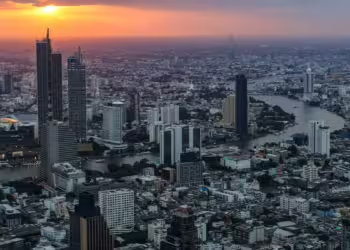No products in the basket.
In 2020 Asia’s GDP will overtake the GDP of the rest of the world combined. By 2030, the region is expected to contribute roughly 60% of global growth. Asia-Pacific will also be responsible for the overwhelming majority (90%) of the 2.4 billion new members of the middle class entering the global economy.
The bulk of that growth will come from the developing markets of China, India and throughout South-East Asia and it will give rise to a host of new decisions for businesses, governments and NGOs. The pressure will be on them to guide Asia’s development in a way that is equitable and designed to solve a host of social and economic problems.
Different countries, different prospects
While these estimates paint a picture of massive growth in consumption, the reality is that consumption patterns will emerge differently across markets, with growth rates dependent on local demographics and other macro factors. For example, as the World Economic Forum’s Future of Consumption in Fast-Growth Consumer Markets work demonstrates, China’s ageing population will negatively impact the population dividend, but rising wages, urban migration, service jobs and an anticipated drop in household savings rates will boost consumption. India’s massive demographic dividend and burgeoning middle class will spur consumption and aid economic growth.
Meanwhile, Indonesia, the Philippines and Malaysia are set to grow their labour forces significantly, leading to a rise in per-capita disposable income. The rapidly advancing digital economy in the region will provide additional access to the previously unserved and deliver on consumer demands for convenience and efficiency.

A new consumer profile
All these macro forces are leading to a bi-polarization of consumption, where consumers will have more power and simultaneously demand both premium and value-for-money goods and services. The consumer of the future is likely to be far more discerning in everything, from what she consumes (personalized/localized/healthy/sustainable) to where she shops (omnichannel, shopping at her convenience) to how she is influenced (less by companies and more by social communities).
Local and regional players gain ground
Employment is expected to rise in healthcare, spurred by the ageing population, for example. However, labour-intensive sectors such as manufacturing, transport and storage are likely to see a reduction in employment levels as a result of automation. It is expected that 53 million workers will have to be reskilled in ASEAN alone. This dynamic is further complicated by the rise of the gig economy, where qualified graduates are taking on jobs as ride-hailing drivers and food delivery couriers.
Questions for companies
The Asian era is here and as companies ramp up their ambitions and efforts, they need to ask themselves several basic questions. Among the most important:
- Do we have a “future-back” strategy (imagining the future and then working on the steps required to position a company to compete in 10 or 20 years) that’s right for the dynamic nature of the region?
- Are we building future-proof competitive advantages and business models?
- What do our consumers want, what new products will serve their needs, how best to engage and serve them?
- How do we handle data?
- Do we have a sustainability agenda that will help support this consumption boom without taking away from the planet even more?
- How should we organize ourselves to be extremely agile to make the most of this unprecedented opportunity?
The new focus on sustainability
Sustainability and its environmental, social and economic impact will also continue to rise on the agendas of governments and NGOs in the region. Both the institutional definition and scope for business will continue to expand to cover topics from health and wellness to diversity and equality opportunities. Investors will also have to play their part: many large investors in Asia-Pacific have started shifting away from primary industries such as oil and gas, mining and agricultural commodities to business models that address environmental and social needs, such as renewable energy and for-profit hospital networks that offer underserved populations better access to healthcare.
A tricky balance for government
As this future unfolds, governments will need to get a few things right. They will need to create trade and investor-friendly reforms, promote social and financial inclusion, invest in hard and soft infrastructure and institute public-private partnerships. They will need to innovate and reform education to ensure there is a competitive and appropriately skilled workforce. While they make these moves, they will be required to balance technological advancement and job creation and talent reskilling, economic development and sustainability, and scale advantages and concentration of power. South-East Asia’s ability to live up to its growth potential will largely depend on it.
License and Republishing
Written by Praneeth Yendamuri, Partner, Bain & Company and Zara Ingilizian, Head of Shaping the Future of Consumption; Member of the Executive Committee, World Economic Forum
The views expressed in this article are those of the author alone and not the World Economic Forum.
Discover more from Thailand Business News
Subscribe to get the latest posts sent to your email.














You must be logged in to post a comment.